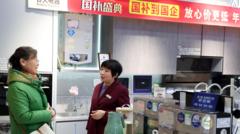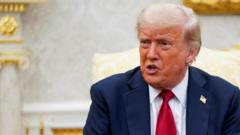China is implementing a broad trade-in scheme aimed at boosting consumer spending as government officials confront persistent economic challenges. The initiative expands a previous program to include kitchen appliances, offering discounts of up to 20% for consumers trading in older items like microwave ovens and dishwashers.
China's New Appliance Trade-In Scheme Aims to Bolster Economic Recovery

China's New Appliance Trade-In Scheme Aims to Bolster Economic Recovery
China's government introduces a new initiative targeting kitchen appliances to stimulate weak consumer demand amid economic trials.
The new list of eligible products also encompasses rice cookers and water purifiers, alongside established categories such as televisions, mobile phones, and electric vehicles. This program is part of a larger government strategy to revitalize the economy, which has struggled with sluggish consumer demand and a worsening property market.
Announced by the top economic planning body, the initiative includes a substantial financial commitment of 81 billion yuan (approximately $11 billion) allocated this year for consumer goods trade-ins. Officials have reported that the measures introduced in March have delivered "visible effects," with increased sales of major items like home appliances and automobiles, according to the Ministry of Commerce.
However, some economists raise concerns about the effectiveness of the trade-in programs. Dan Wang, a China-based economist, suggested that while certain sectors have seen support, overall consumer spending remains lackluster. Moody's Analytics' head of China economics, Harry Murphy Cruise, echoed this sentiment, noting that the measures fall short of significantly uplifting general consumption levels.
In response to these challenges, China's leadership has highlighted the need for "vigorous" actions to stimulate consumer spending. Compounded by global trade tensions, including potential tariffs under a new U.S. administration, China is poised to release its economic growth projections for 2024 next week, with expectations set around 5%.
Announced by the top economic planning body, the initiative includes a substantial financial commitment of 81 billion yuan (approximately $11 billion) allocated this year for consumer goods trade-ins. Officials have reported that the measures introduced in March have delivered "visible effects," with increased sales of major items like home appliances and automobiles, according to the Ministry of Commerce.
However, some economists raise concerns about the effectiveness of the trade-in programs. Dan Wang, a China-based economist, suggested that while certain sectors have seen support, overall consumer spending remains lackluster. Moody's Analytics' head of China economics, Harry Murphy Cruise, echoed this sentiment, noting that the measures fall short of significantly uplifting general consumption levels.
In response to these challenges, China's leadership has highlighted the need for "vigorous" actions to stimulate consumer spending. Compounded by global trade tensions, including potential tariffs under a new U.S. administration, China is poised to release its economic growth projections for 2024 next week, with expectations set around 5%.




















